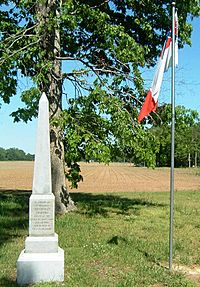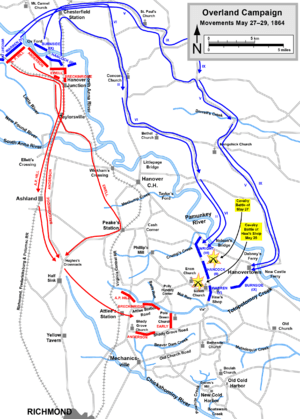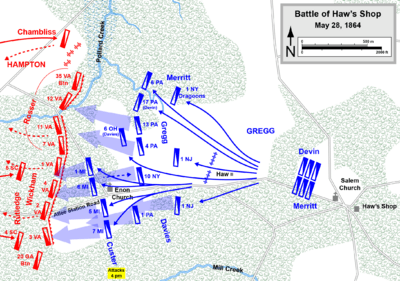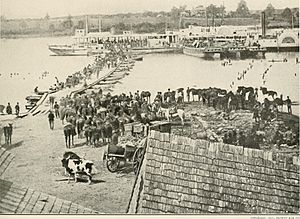Battle of Haw's Shop facts for kids
Quick facts for kids Battle of Haw's Shop |
|||||||
|---|---|---|---|---|---|---|---|
| Part of the American Civil War | |||||||
 View east across the battlefield from Enon Church |
|||||||
|
|||||||
| Belligerents | |||||||
| Commanders and leaders | |||||||
| David McM. Gregg | Wade Hampton | ||||||
| Strength | |||||||
| 4,000 | 4,500 | ||||||
| Casualties and losses | |||||||
| 365 | 378 | ||||||
The Battle of Haw's Shop, also known as the Battle of Enon Church, was a fight during the American Civil War. It happened on May 28, 1864, in Hanover County, Virginia. This battle was part of a larger plan by Union Lieutenant General Ulysses S. Grant called the Overland Campaign. He was trying to defeat Confederate General Robert E. Lee and his Army of Northern Virginia.
After a tough battle at Battle of North Anna, Grant decided to move his army again. He tried to go around Lee's right side, using the Pamunkey River to hide his movements. Lee's army moved south to block Grant. General Lee sent his cavalry (soldiers on horseback) led by Major General Wade Hampton III to find out what Grant was doing.
On May 28, Hampton's cavalry met Union cavalry led by Brigadier General David McMurtrie Gregg. The soldiers mostly fought on foot, using dirt walls for protection. Neither side gained a clear advantage. General Gregg's troops got help from other Union cavalry units, including one led by Brigadier General George Armstrong Custer. Custer's men made a strong attack just as Hampton was telling his soldiers to pull back.
The battle lasted seven hours and was very bloody for a cavalry fight. Both sides said they won. Union cavalry commander Major General Philip Sheridan said his men pushed Hampton away. But Hampton had stopped the Union cavalry for hours. He kept them from finding out what he needed to know. He also sent important information about Grant's army back to General Lee.
Contents
Why the Battle of Haw's Shop Happened

After the Battle of North Anna, Grant and Lee's armies were stuck. They faced each other from behind dirt walls. Grant wanted to move his army again, just like he had done after earlier battles. He hoped to get closer to the Confederate capital, Richmond, Virginia. He also wanted to make Lee fight him in the open.
Grant decided to move east and cross the Pamunkey River. This river would hide his army from the Confederates. It also made it easy for him to get supplies from a new base at White House Landing.
Grant's Tricky Plan to Move His Army
Before moving, Grant had to get his army away from Lee's without being attacked. His soldiers had to cross the North Anna River to the north first. This made them very open to attack. Grant came up with a plan to trick Lee.
On May 26, he sent some cavalry to the west. This made Lee think Grant was moving in that direction. At the same time, other cavalry units went to the Pamunkey River, far from where Grant really planned to cross. Lee, who was sick, believed Grant was moving west.
The Union foot soldiers secretly left their positions after dark on May 26. By the next morning, they were all safely north of the North Anna River. Some Union corps stayed to guard the river crossings. Other corps, led by cavalry, began marching southeast toward Hanovertown.
Lee's Quick Response
Once Lee realized Grant had moved, he quickly moved his own army. His three corps marched south toward Atlee's Station. This spot was only 9 miles north of Richmond. From there, his soldiers could defend against Grant behind a stream called Totopotomoy Creek.
Lee also sent a small group of cavalry to scout along the Pamunkey River. They were to find and bother the Union army. Lee was still sick during this march and had to ride in a carriage. Another general, Ewell, was also sick and was temporarily replaced.
Union Cavalry Crosses the Pamunkey
On May 27, Union cavalry crossed the Pamunkey River at Dabney's Ford. Brigadier General George Armstrong Custer's cavalry scattered the Confederate guards. Engineers quickly built a bridge for the rest of the army.
Custer's men fought a short battle north of Salem Church against Confederate cavalry. The Confederates pulled back because the Union forces were stronger. More Union cavalry and foot soldiers then crossed the river.
Lee knew that the best place to defend against Grant was a ridge south of Totopotomoy Creek. But he wasn't sure exactly what Grant planned to do. If Grant wasn't crossing the Pamunkey in full force, he might go straight to Richmond. So, Lee ordered Major General Wade Hampton III to take his cavalry and find the Union foot soldiers.
| Commanders at Haw's Shop |
|---|
|
Who Fought at Haw's Shop
Confederate Major General Wade Hampton was one of the top cavalry leaders. He brought his Laurel Brigade and other units. These included new, less experienced soldiers from South Carolina. He also had some horse artillery (cannons pulled by horses).
The main Union cavalry force was the 2nd Division, led by Brigadier General David McMurtrie Gregg. His division had two brigades. Later, more Union cavalry arrived from Brigadier General Alfred Thomas Archimedes Torbert's division. These included brigades led by Brigadier General George Armstrong Custer and Brigadier General Wesley Merritt.
The Battle Begins
At 8 a.m. on May 28, Hampton's cavalry left Atlee's Station. As more of Grant's foot soldiers crossed the Pamunkey River, General Gregg's cavalry moved west from Hanovertown. They were looking for Lee's army.
Three miles west of Hanovertown, Gregg's soldiers found Hampton's Confederates. They were near a blacksmith shop called Haw's Shop and a church called Enon Church. The Confederate cavalry had gotten off their horses. They were quickly building dirt and log walls for protection in a wooded area. They also had cannons ready.
The Confederates were spread out in a line. They had dug shallow trenches and put logs and fence rails in front of them. It was hard to go around their position because of swamps on both sides. Hampton saw the smaller Union force and reportedly said, "We've got the Yankees where we want them now."
Fierce Fighting and Reinforcements
Before Hampton could attack, more Union cavalry arrived. They spread out to make the Union line longer. Union cannons were set up near the Haw house. The Confederates tried a charge, but the Union soldiers pushed them back. However, the Confederates soon began to surround the Union troops.
More Union soldiers arrived and helped stabilize the lines. Hampton sent in his new, inexperienced South Carolina troops. They met the next Union attack with heavy gunfire. These Confederates had rifles that could shoot farther than the carbines (shorter rifles) the Union cavalry used. This caused many Union casualties.
But the Union soldiers also fired a lot. They had Spencer repeating carbines, which could fire seven shots quickly. One Union soldier said his unit of 200 men fired 18,000 rounds. Their carbines got so hot they had to stop to let them cool down.
As the first Union attacks slowed, General David Gregg asked for more help. General Sheridan sent two brigades from Torbert's division. One brigade, led by General Merritt, made the Union line longer to the right. This stopped Hampton from trying to go around the Union side.
Custer's Charge and Confederate Retreat
There were many Union foot soldiers nearby who could have helped. But there is no clear record that General Sheridan asked for their help.
General Custer's brigade arrived around 4 p.m. Custer's men got off their horses and formed a long line, like foot soldiers. Custer himself stayed on his horse. He waved his hat and led his men forward, while his band played Yankee Doodle. He was a very showy general.
Custer's men faced heavy rifle and cannon fire. Forty-one Union cavalrymen fell in the attack. Custer's horse was shot, which was the seventh time he lost a horse in the war. Custer later said his brigade lost more men at Haw's Shop than in any other battle of the campaign.
Meanwhile, a Confederate soldier mistakenly thought some Union cavalry were foot soldiers. He reported this to Hampton. Hampton worried his cavalry would be trapped and defeated by an infantry attack. So, he ordered his men to start pulling back. Hampton had also just learned where two Union corps had crossed the Pamunkey. This meant his mission to gather information was complete.
The Confederate brigades pulled back one by one. As they left, Custer's men charged forward. They overran some Georgian soldiers, killing their commander and capturing many men. Other Union brigades joined the attack. The remaining Confederate line broke apart. But by nightfall, Hampton's cavalry was safely west of Totopotomoy Creek.
After the Battle
The Battle of Haw's Shop lasted over seven hours. It was one of the bloodiest cavalry battles since Battle of Brandy Station in 1863. It was unusual because most of the fighting was done by cavalry soldiers on foot, often protected by dirt walls.
The Union army had 256 casualties in Gregg's division and 41 from Custer's brigade. This included Private John Huff, the soldier who had shot Confederate Major General J.E.B. Stuart at Battle of Yellow Tavern. Confederate losses were not officially counted. But Union reports said they buried 187 enemy bodies. They also found 40 to 50 wounded men and captured 80 South Carolinians.
Both sides said they won. General Sheridan bragged that his men had pushed Hampton away. He said it showed how good the Union cavalry was. But some historians say Sheridan missed a chance to destroy Hampton's forces. He could have used his whole cavalry corps to do it. Instead, he made costly attacks from the front.
Hampton's claim of victory was also fair. He had stopped Sheridan from finding out where Lee's army was. He also delayed the Union advance for seven hours. General Lee got the important information he needed. He now knew that Grant had crossed the Pamunkey in full force. The two armies would fight again nearby on May 30 in the Battle of Totopotomoy Creek.
Images for kids









